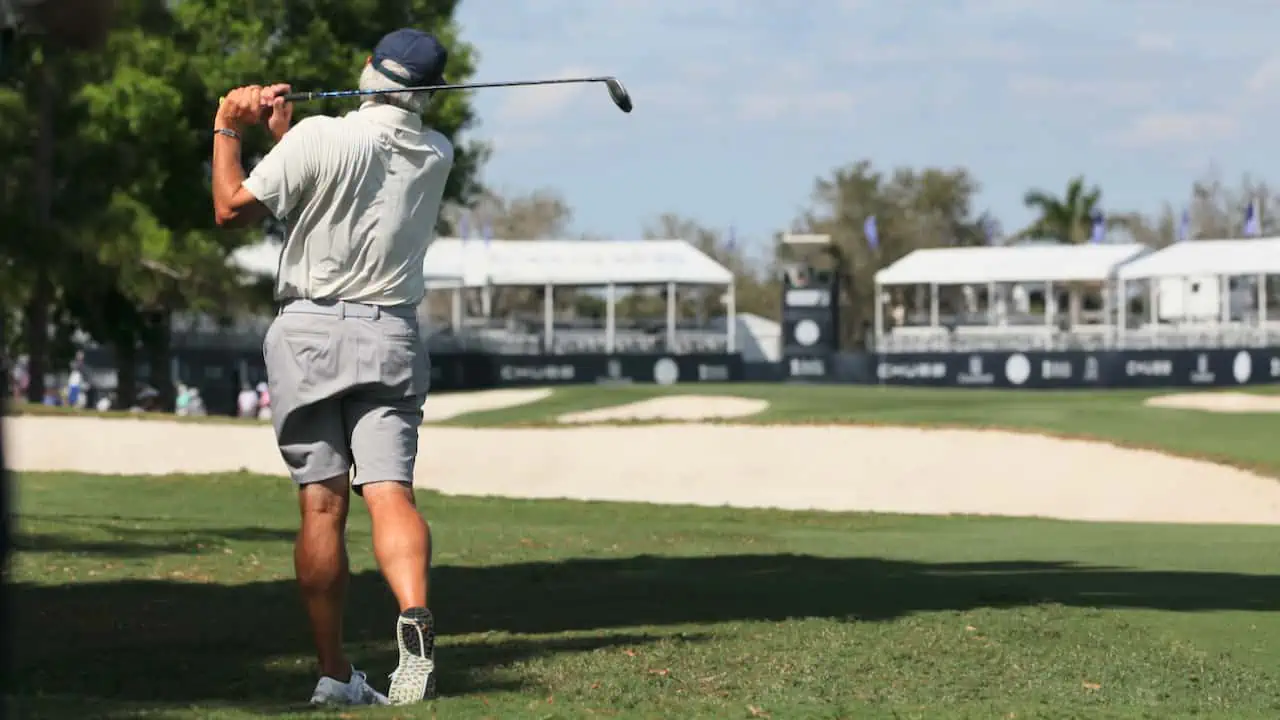Table of Contents
In the world of golf, few have made a mark quite like Fred Couples. The Fred Couples golf swing is legendary for its ultra smooth and effortless look.
With 15 PGA Tour wins, 5 International (1992 Masters), and 14 Champions Tour wins, he has proven his abilities across several decades and continents. Although Freddie has encountered a few health setbacks through the years, his swing has changed very little.
Like many golfers, his bad back contributed to his limited playing schedule. You might ask yourself, “Why does such a classically fluid motion cause him any pain?”
In this article, I will help you understand how he builds power and what he does that initiates the occasional flare-up. We will start with understanding the swing concepts that form the foundation of his powerful golf swing sequence which are the backswing takeaway, hip rotation, and release to target line.
⛳️ Related: What’s in Fred Couples’ Golf Bag
Fred Couples Golf Swing Analysis
Standing at 5’11’’ tall, the young Couples burst onto the PGA Tour scene with his first win at the 1983 Kemper Open at Congressional Country Club and has never looked back.
His explosive drives and style brought in record crowds, causing a significant shift in the game of golf.
Of course, there have been long-ball hitters prior to his arrival, such as Sam Snead and Walter Hagen, but Couples’ silky swing brought forth a new wave of power hitters.
The first key element to his success was how he initiated his backswing with an outside-the-target line motion, which allowed him to generate width to the arc of his backswing.
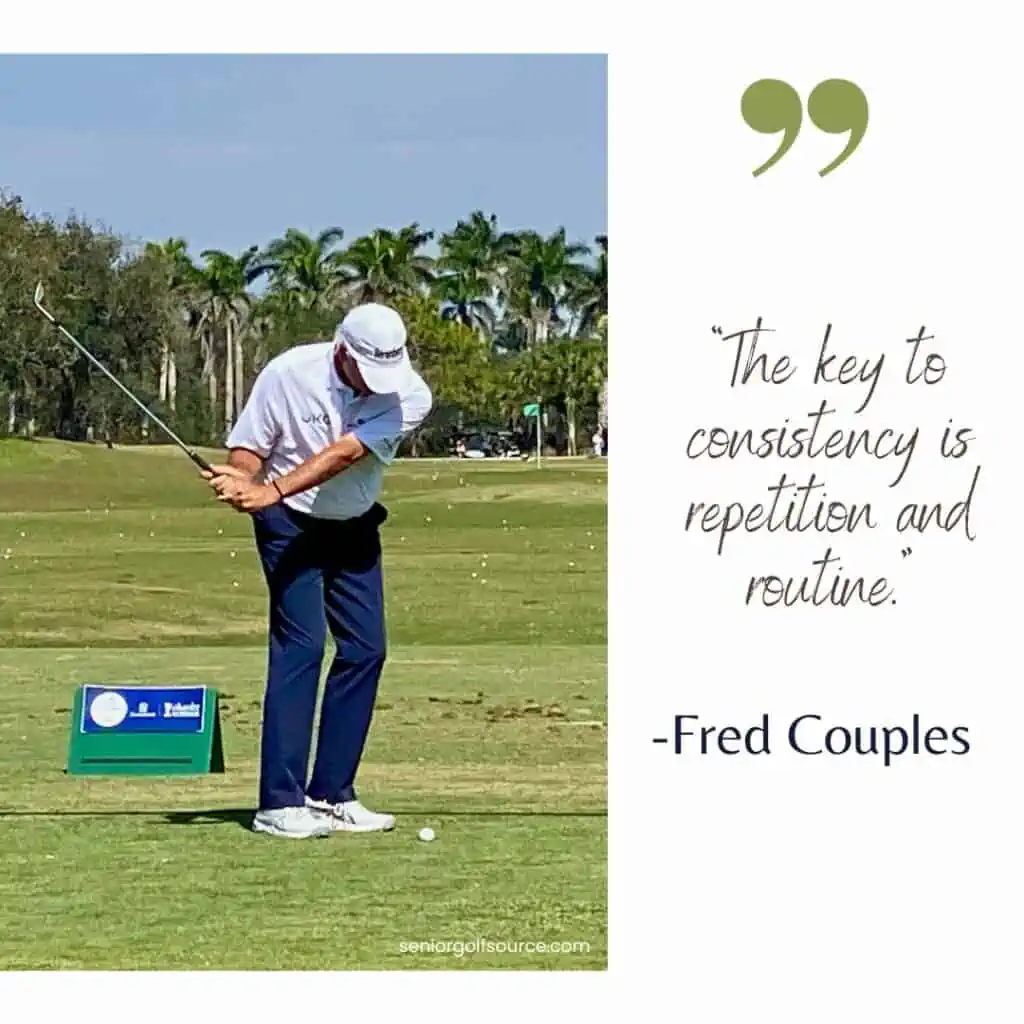
One side note that significantly affects your backswing path is tempo. Most players will take the club back too fast, which doesn’t allow them to feel where the club is in space. Try using the tempo you would use, hitting a 7 iron when taking your driver back.
Now that tempo has been addressed, let’s understand what an outside-the-target line means. First, we will need to establish a clear comprehension of the target line.
Imagine that you are standing on a set of parallel railroad tracks that point to a target. For right-hand golfers, the golf ball would be placed on the line on the right, and our feet would be on the line to the left.
The image below will visually show the difference between an inside-the-target line (left side image), on-plane (center image), and outside-the-target line (right side image) takeaway.
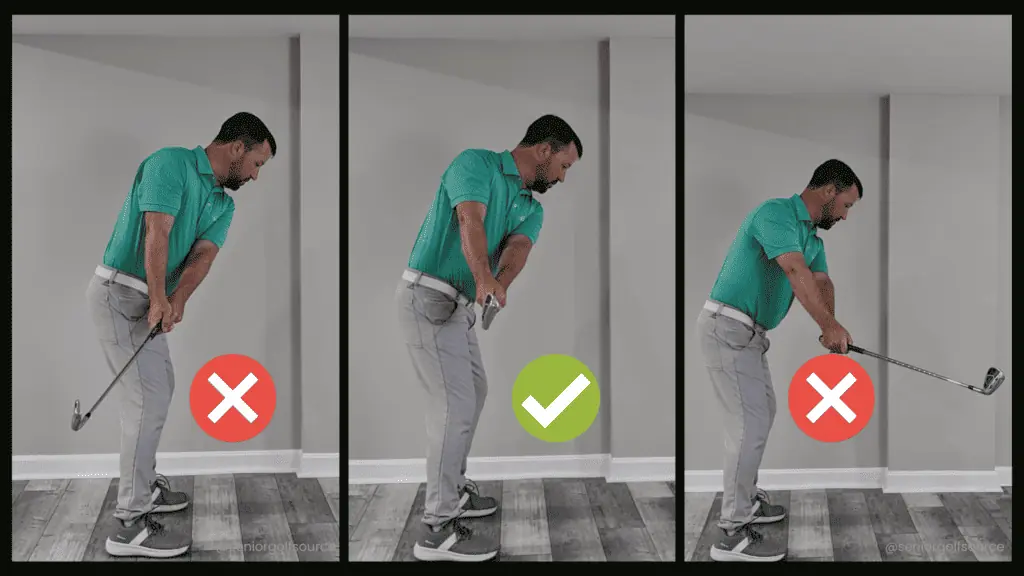
Most amateur golfers tend to move the club back on an inside-the-target line takeaway, which limits the potential width of the arc of their backswing. In many cases, this drastically affects the downswing path. Resulting in a more over-the-top downswing path that lacks power.
This typical mistake happens early in the swing and is commonly known as the origin of the slice. Once this takes place, the rest of your swing is spent trying to compensate for an easily curable solution. The video below will go into detail and give you the cause vs. effect possibilities to assist with further understanding ball flight laws.
Drill for an On Plane Backswing
Items Required: Alignment stick or extra club and a pitching wedge.
- Place the alignment stick or extra club directly on the ground so the tip of your toes on both feet are touching it.
- Slide the alignment stick or extra golf club away from your target line by roughly 2’-3’.
- Take your golf backswing very slowly and pause once the club shaft is parallel to the horizon.
- Once the golf club is parallel to the horizon, it should also be parallel to the alignment stick/extra club that is in line with your stance.
Cause of Potential Golf Back Pain Flare-up
Given the extensive shoulder turn that Fred Couples golf swing generates, a significant amount of pressure is being placed on his lower back because his left heel (flat foot) remains grounded throughout his swing.
If you’re a golfer, you’ve probably had the concept of keeping your left foot nailed on the ground, particularly in the backswing.
I’m not advocating the opposite or telling you this concept is wrong, but the statement that all things are good in moderation remains true. It all depends on your abilities and limitations.
One of my favorite teachers of all time, Harvey Penick, stated that everyone has their own unique golf swing. This teaching approach supports the simple fact that no two swings are exactly alike, no matter how you try.
While some players confide in the long-practiced method of keeping their left heel down in the backswing, others capitalize on doing the exact opposite.
For example, Fred Couples swing obviously does well with this concept, while players like Jack Nicholas, Bryson DeChambeau, and Bubba Watson rely heavily on going against the grain.
At the end of the day, the combination of excessive shoulder turn paired with left heel position is the sum of Fred’s lower back issues.
Golf Stretches for Lower Back Pain
- Take a wide golf stance and press your hips forward. While the hips are forward, squeeze your glutes and hold for 3-5 seconds. Repeat five times.
- Place a club behind your head so it rests on your shoulders. Grab the golf club with both hands and twist the torso right and left in a slow pattern.
- Lay on your back with your knees bent and feet flat to the ground. Next, lift your hips up and squeeze your glutes. Hold the squeeze for 3-5 seconds. Repeat 7-10 times.
The Fred Couples Swing & Hip Rotation
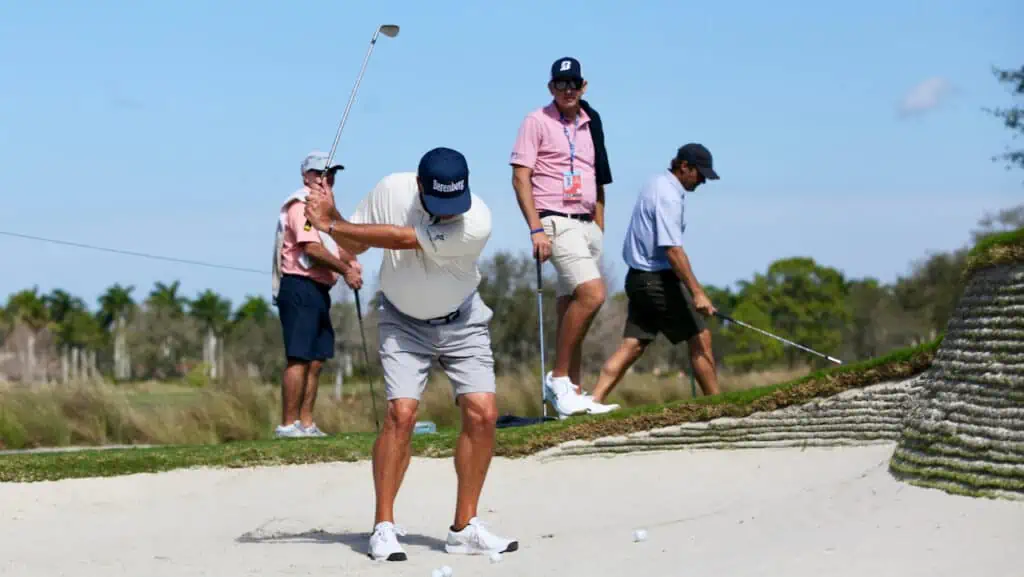
The second factor contributing to Fred Couples swing power is his hip rotation in the downswing transition. Even at the distinguished young age of 64, Freddie delivers dominant hip rotation faster than most players half his age.
Consequently, he routinely hits powerful drives 290+ yards on average. As the downswing is initiated, Couples uses his body rotation to transfer weight and power. The key position of the hips just before impact should be open to the target line. This ensures proper sequencing in the downswing, a major contribution to why his golf swing looks so effortless and balanced.
To better understand the concept of golf swing hip rotation sequence, let’s consider the athletic order of throwing a ball or landing a punch. The natural reaction is to draw back the delivering arm while rotating the body away from its target, then turn the body towards the intended target and let your upper body (shoulders & arms) gain momentum from lower body movement.
On the other hand, if you decide to punch or throw with only your arm strength, you will deplete your maximum potential due to a lack of body rotation and weight transfer.
As a result, your delivery will fatigue you in a short period of time – with very little energy exerted. The hips must lead the forward motion to impact to capitalize on your power.
If you’ve ever heard the term power comes from the ground up, this references your leg and hip motion.
Proper Golf Swing Hip Rotation Drill
Required Items: 1 chair and a 7 iron
- Place the chair in the opposite direction so the seat faces away from you.
- Take your stance so the backside of the chair is touching your glutes.
- Proceed to set your backswing. Your trailing glute should feel connected to the backside of the chair.
- In your downswing, your glute closest to the target should now feel connected to the backside of the chair. Note that your leg closest to the target should straighten at the knee.
- Monitoring your motion in front of a mirror is highly recommended. The mirror should be positioned so you can see the chair and your backside.
🏌️♂️ Read Next: Why Can’t I Hit My Driver: Tips to Improve Your Swing
Fred Couples Drive: Club Face Release to Target Line
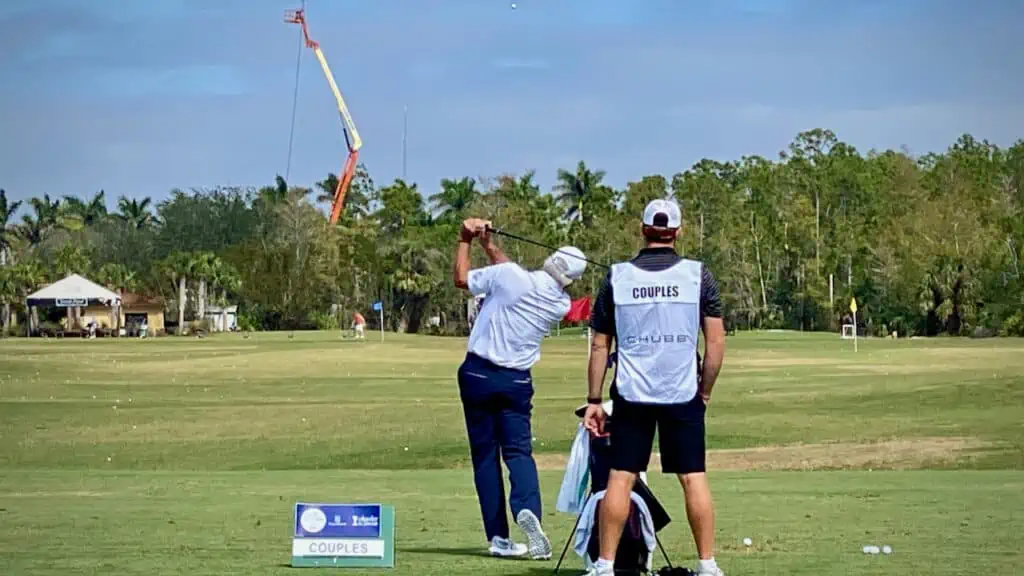
The third factor that permits Fred Couples drive to routinely generate substantial power while maintaining control is how he releases the club through impact.
Without his signature release, Couples would not be capable of hitting his fearless draws repeatedly with the big stick. The clubface release through impact directly correlates with ball flight control.
For example, if the clubface is pointed towards the sky after impact takes place, then the shot will have greater potential to move directionally to the right.
One of the easiest ways to develop a release is to rehearse and examine your arm and hand positions post-impact. If you’re battling a slice or hook, pay close attention to the next few suggestions.
Baseline Factors to Improve Ball Flight
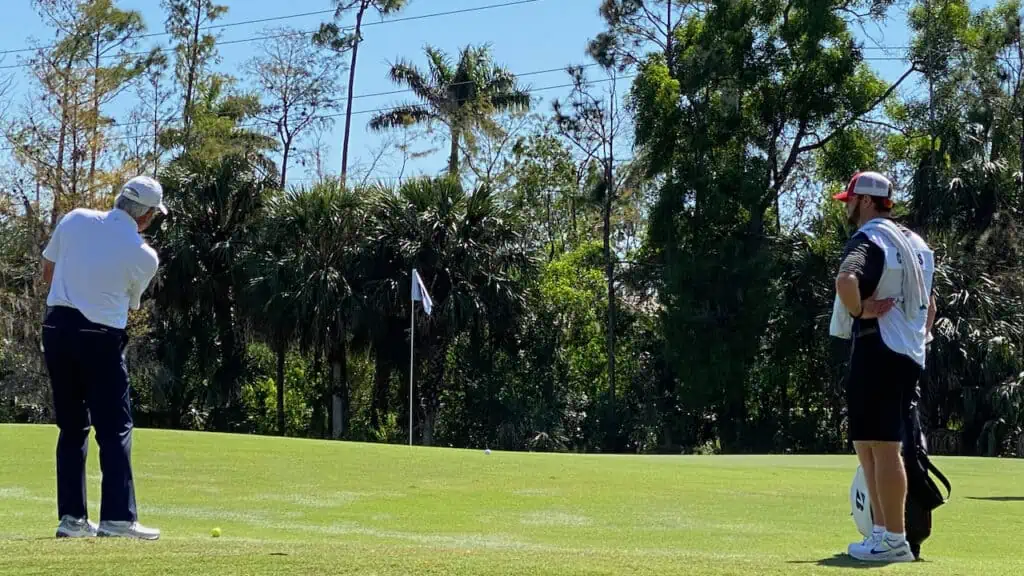
In this section we will cover some baseline factors and a drill designed to improve your ball flight.
The path is the direction in which the clubhead is traveling towards the ball. Essentially, two different types of paths can occur in the golf swing sequence. The most coveted of the two golf swing paths is an in-to-out path, which produces powerful compression depending on the clubface position.
For example, an in-to-out path with an open clubface will produce a push to the right. A slightly closed face with a slightly in-to-out path will produce a dominantly straight shot. If the clubface is more closed, the ball will start to hook.
On the other side of the equation, a slice develops from an outside-to-in path with a slightly open face. If the clubface is more closed with an outside-to-in path, then a pull-hook is formulated. Fred Couples swing delivers an in-to-out path with a slightly closed face, which supports his explosive distance and accuracy.
Golf Swing Release Drill
Required Item: Football
Imagine holding a football between both palms at address so the laces are visible, with a pointed end of the ball facing down at the ground while the other end is pointing towards your chest. To execute this drill, start by taking a small backswing and initiate the forward motion.
Next, directly at or slightly after impact, rotate the football so the end that was pointed at the ground now faces the target, and the laces appear to be turning to the left. If you were to release the ball at this point, it would develop a tight spiral to the left while it travels directly down the target line. If you hold your position prior to releasing the ball from your palms, you will notice that your right arm should be extended with the right palm facing towards the ground while the left arm is slightly bent while the left elbow is facing the ground.
Please be advised if you do this with a quick tempo. The club face will most likely shut down and cause the ball to turn left.
Key Points to How to Fix a Slice
- The trail arm feels extended to the target with your palm facing down.
- Lead elbow pointed towards the ground with your palm facing up.
- The club face position should be toe-up post-impact.
Final Thoughts on Fred Couples Golf Swing
In conclusion, the Fred Couples golf swing is still a force to be dealt with on the highest levels due to its timeliness characteristics.
I encourage you to absorb this information and implement some of these drills into your golf game. Remember, that no two golf swings are identical, so make it your own. Enjoy your time on the range and golf course, my friends!

